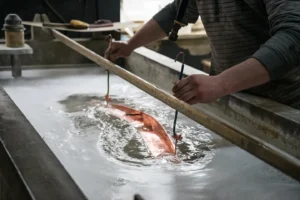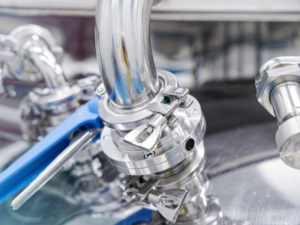Electropolishing services offer many benefits for stainless steel parts.
Depending on the end-use of the product, the advantages of electropolishing can include:
- Enhancing aesthetics –
- Deburring –
- Passivation –
- Eliminating oxide scale –
- Reducing surface material –
- Eliminating surface inclusions –
- Improving corrosion resistance –
- Improving adhesion for subsequent finishes –
For high purity applications such as the interior of pipe system components where the level of finish is critical, electropolishing services remove impurities, inclusions, and other contaminants to improve cleanability, durability, and corrosion resistance.
Electropolishing Services for 300 Series Stainless Steel
Stainless steel is steel that holds up longer to extreme corrosive and temperature conditions. The primary difference between stainless steel and other alloys is the quality of the alloy and the percentage of carbon it contains. Stainless steel must include .1% to .2% carbon and more than 12% chromium.
The 300 series includes more than a dozen types that are considered austenitic stainless steel. They are nonmagnetic and cannot be hardened by heat treatment. The 304 and 316 are considered austenitic and the most commonly used stainless steel alloys. The difference between the two is that 304 contains 18% chromium and 8% nickel while 316 contains 16% chromium, 10% nickel and 2% molybdenum. Chromium increases tensile strength, hardness, and resistance to wear, abrasion, corrosion, and scaling. Nickel increases strength, hardness, corrosion resistance, and ductility. Molybdenum adds corrosion resistance and elevated temperature strength.
Type 304 is a lower-cost corrosion-resistant alloy used to produce products like kitchen equipment, food processing equipment, heat exchangers, storage tanks, pressure vessels, and piping.
Type 316 stainless steel contains molybdenum and offers comparatively superior heat resistance and corrosion resistance making it ideal for products such as pumps, valves, chemical equipment, clean room equipment, pharmaceutical manufacturing equipment, and marine applications.
Electropolishing the 300 series stainless steels eliminates burrs and imperfections to produce a smooth and often shiny surface. These alloys can be electropolished to mirror finish.
Electropolishing Services 400 Series Stainless Steel
Many of the 400 series fall into the category of ferritic stainless steels including 405, 409, 429, 430, 434, 436, 442, and 446. They have lower chromium and nickel content than austenitic steels, but also contain molybdenum, aluminum, and titanium. They are known for their good ductility and resistance to stress corrosion cracking. Some applications include heat exchanges, automotive exhaust, appliances, and food equipment.
The 403, 410, 414, 416, 420, 432, 440 alloys are martensitic stainless steels that have higher levels of carbon and lower levels of chromium than ferritic. The martensitic crystalline structure of these alloys provides products with high-strength and high-wear resistance. Examples of applications using these metals include cutlery, dental and surgical instruments, valves, and pumps.
On 400 series stainless steels, electropolishing provides deburring, cleaning, and passivation but it does not result in a lustrous finish.
Corrosion resistance, stain resistance, low maintenance, and cost-effectiveness make it a versatile material that can be used across industries. Some examples of industry applications include agricultural equipment, automotive exhaust system components heat exchangers, food industry equipment, hardware, surgical tools, and knives.
Electropolishing Services at AMF Technologies
For reliable quality and on-time delivery, you can trust AMF Technologies’ experience and expertise to meet your specifications and timelines. We also provide fast and accurate quotes so you can keep things moving. Contact us here or call us at 781-982-0137.














